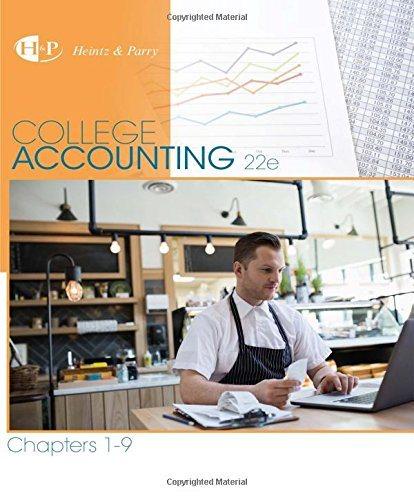Question
King wanted to purchase the business but explained that he could not afford to pay the entire amount in cash. Becker was eager to sell,
King wanted to purchase the business but explained that he could not afford to pay the entire amount in cash. Becker was eager to sell, so she proposed to settle for $45,000 cash and an 8year loan for the remaining $80,000. The loan would be secured by the land and building, bear a 10% interest rate, and require annual payments of $10,000 plus accrued interest.
After some discussion, King agreed to these terms and signed a purchase agreement. No cash was exchanged at this stage.
Organizing the New Business
King immediately began organizing his business. He was able to contribute $60,000 in cash to the firm after depleting his personal savings and cashing in an insurance policy he owned. On March 31, settlement papers were signed, and the title was transferred from Becker to King. King paid $50,000the $45,000 down payment plus $5,000 for closing costs related to the loan for the land and building.1
King decided to allocate the $125,000 purchase price as follows: $20,000 for the land, $80,000 for the building, $8,500 for fixtures and equipment, and $16,500 for inventory. He based this allocation on a fair market appraisal value of the land and building (not on often unreliable county tax records) and the historical cost of the merchandise in inventory. However, he was unsure how the $5,000 of closing costs should be treated.
On the final day of March, King was busy preparing his store for opening:
a. He purchased a fire insurance policy covering the building and its contents and paid the $1,200 annual premium in advance.
b. Additional shelving and fixtures were purchased for $1,300 cash.
c. A shipment of books arrived accompanied by an invoice2 for $2,800.
Opening for Business
On April 1, King opened his store and greeted his first customers.
Summary data for the remainder of the year include:
d. Cash sales for the 9month period ending December 31, totaled $62,300. All sales for the nine months were collected in cash except for one sale to a large local resort in late December. This customer special ordered $4,000 of books to be given out at the resorts new years millennium-eve gala. The books arrived in late December and were delivered to the customer who promised to pay in early January. Thus, the $4,000 amount is not included in the above cash sales total.
e. Between April 1 and December 31, Haystack Bookstore took delivery of inventory costing $43,900. This merchandise was purchased on account.3
f. King paid $42,100 in cash to suppliers for the merchandise purchased in c and e.
g. The cost of telephone service, electricity, and other utilities came to $1,900 during the AprilDecember period. These costs were paid in cash.
h. King paid $2,800 to part-time employees during the busy summer season.
i. King paid himself a salary of $9,000.
j. The historical cost of inventory on hand on December 31 was $19,600.
k. King determined that the building had a useful life of twenty years and that the fixtures and equipment should be depreciated over five years. Of these useful lives, nine months had elapsed.
- How much is the Total Asset on 3/31/xx?
- How much is the Total Asset on 12/31/xx?
- How much is the Cost of Goods Sold in the period?
- How much is the total loss/profit for the period?
- Prepare all the journal entries from March 31.
- Prepare a Cash Flow statement for the entire period. Use the indirect method for the Operating Activities.
- What should happen if, instead of a salary, the company pays the owner with a dividend? What would be the impact on the Balance Sheet, Income Statement and Cash Flow Statement?
Step by Step Solution
There are 3 Steps involved in it
Step: 1

Get Instant Access to Expert-Tailored Solutions
See step-by-step solutions with expert insights and AI powered tools for academic success
Step: 2

Step: 3

Ace Your Homework with AI
Get the answers you need in no time with our AI-driven, step-by-step assistance
Get Started


